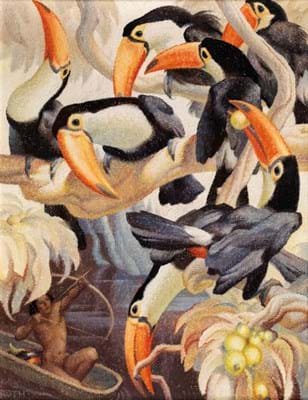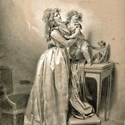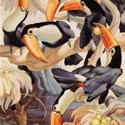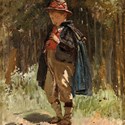In 1772 the French wallpaper manufacturer Jean-Baptiste Réveillon (1725-1811) bought a paper mill in Courtalin-en-Brie, outside Paris, where he set about manufacturing vellum. After numerous experiments he succeeded in creating high-quality paper, not just for his own products, but also as supplies for artists.
Among them was Louis-Léopold Boilly (1761-1845) to whom a charcoal drawing of The Frightened Child offered by Schmidt (21% buyer’s premium) in Dresden on March 25 was attributed. The artist used blueish Courtalin paper, cut from a larger sheet for his composition – part of the watermark is still visible.
The motif is repeated in a more extensive oil painting titled The Dead Mouse, which belongs to the Wallace Collection in London. It reveals the cause for the young child’s distress: a young woman in a doorway is dangling a dead mouse by its tail.
This picture is thought to have been painted in about 1793; the drawing is most probably a preparatory work.
Boilly managed to continue his career throughout one of the most turbulent periods of French history, from the overthrow of the monarchy, the terror of the revolution, the Napoleonic era and the Bourbon Restoration. It is thought that he painted over 500 genre paintings and up to 500 small portraits.
This 1ft 11in x 17in (59 x 43cm) drawing has an interesting provenance. It once belonged to the late 19th century Munich painter Franz von Lenbach, famous in his own right for his genre painting and portraits, and had passed by descent to one of his great-grandchildren.
These features all added strength to the identity of the work which, although unsigned, has a pretty solid attribution and is to be included in the artist’s catalogue raisonné. At the sale last month it easily outstripped its €40,000 estimate to sell for €108,000 (£93,925).
This was not, however, the highest price in the Dresden sale.
That accolade was awarded to a watercolour on paper by the Swedish modernist Gosta Adrian-Nilsson (1884-1965). Dated to 1917 and monogrammed G.A.N. to the lower left, the 21 x 18in (54 x 46cm) work mounted on card depicted an abstracted marinescape in Halmstad.
It had been guided at a modest €7000 but was taken to a very substantial €240,000 (£208,695).
The Austrian painter Norbertine Bresslern-Roth (1891-1978) devoted much of her career to portraying animals and birds. She was considered a masterful painter in oil, but was also a highly accomplished linocut artist.
A work offered in the auction series held by Kinsky (26/22/17% buyer’s premium) in Vienna from February 28-March 1 showed that her popularity has not waned. The 2ft 11in x 2ft 4in (90 x 70cm) painting Tukanjäger (Toucan Hunter), in oil on jute, from 1943, was the star of the show.
It was characteristic of the artist’s work. Since a visit to Africa in 1928, her paintings were dominated by the bold use of intense colours.
Tukanjäger was shown at exhibitions in Bresslern-Roth’s home town of Graz in 1949 and 1952, but remained in her possession until the 1960s, at which time it was sold to a local collector, who had owned it ever since.
Many of her subjects were of exotic birds from far-away countries, such as the toucans shown here, but in the event it was an Austrian collector who placed the multi-estimate winning bid of €70,000 (£60,870).
An early painting by the German artist Max Liebermann (1847-1935) took top honours at the sale held by Kastern (22% buyer’s premium) in Hanover on March 4.
His 16 x 12in (40 x 33cm) Pifferaro – Savojardenknabe (Young Savoyard Boy Playing the Piffero), showing a young boy playing a reed pipe often used by shepherds, was dated 1869, while Liebermann was studying in Weimar.
The influence of Franz von Lenbach, one of his teachers there, is clearly noticeable.
Kastern was expecting €40,000- 50,000 for the well documented painting, which was last sold at Sotheby’s in 1990 and has been part of a north German collection ever since. It changed hands for €65,000 (£56,520) and will soon be made available to the wider public as the successful bidder was a museum.
(£1 = €1.15)




















